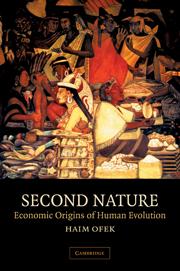Book contents
- Frontmatter
- Contents
- Acknowledgments
- 1 Introduction
- Part 1 Bioeconomics
- Part 2 Paleoeconomics
- 8 Departure from the feed-as-you-go strategy
- 9 The origins of market exchange
- 10 Domestication of fire in relation to market exchange
- 11 The Upper Paleolithic and other creative explosions
- 12 Transition to agriculture: the limiting factor
- 13 Transition to agriculture: the facilitating factor
- References
- Index
8 - Departure from the feed-as-you-go strategy
Published online by Cambridge University Press: 06 July 2010
- Frontmatter
- Contents
- Acknowledgments
- 1 Introduction
- Part 1 Bioeconomics
- Part 2 Paleoeconomics
- 8 Departure from the feed-as-you-go strategy
- 9 The origins of market exchange
- 10 Domestication of fire in relation to market exchange
- 11 The Upper Paleolithic and other creative explosions
- 12 Transition to agriculture: the limiting factor
- 13 Transition to agriculture: the facilitating factor
- References
- Index
Summary
The first appearance of manufactured stone tools in widespread systematic human use, about 2 million years ago, in combination with other evidence (e.g., food sharing), suggests the possibility that some form of exchange, however primitive, was already practiced by traders with brains half the size of a modern human being. If true, the implication is that exchange could have played an important facilitating role already in the first major economic transition in human (or protohuman) history – the transition from the feed-as-you-go strategy of primate feeding to hunting-gathering. The discussion in this chapter will consider these possibilities in light of the available paleoarcheological data, starting with a preliminary review of the physical environment.
The physical environment
The single most important factor that describes the theater of events in evolution, certainly in human evolution, is climate. The global climate in which civilization flourished is the wrong environmental model for understanding human evolution not only throughout the long ice ages (nearly 90% of the time humans walk the earth) but, in all likelihood, also in the course of the short spikes of interglacial periods (the remaining 10%). The climate observed today and enjoyed by (anatomically) modern people over the past 10,000 years is a placidly warmand, arguably, all too brief interval in a long process of falling temperatures starting about 3.2 million years ago (and greatly intensifying roughly 2.4 million years ago and then again about 900,000 years ago).
- Type
- Chapter
- Information
- Second NatureEconomic Origins of Human Evolution, pp. 125 - 137Publisher: Cambridge University PressPrint publication year: 2001

